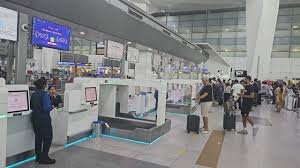Delhi Airport Launches India’s First Self-Service Mechanism for Check-in Luggage
Introduction
The Delhi International Airport Ltd (DIAL) has revolutionized the check-in process by launching India’s first self-service mechanism for check-in luggage on June 17, 2024. This advancement aims to streamline the passenger experience, reducing check-in times significantly.
Installation of Self-Service Bag Drop (SSBD)
Indira Gandhi International (IGI) Airport now boasts around 50 Self-Service Bag Drop (SSBD) units across Terminals 1 and 3. These units are operational with three major airlines: Air India, IndiGo, and Air India Express. This system allows passengers to efficiently drop off their luggage, collect tags, and print boarding passes, all through a streamlined self-service process.
How the Mechanism Functions
Upon arriving at the airport, passengers can use Common-Use Self-Service (CUSS) kiosks to collect and attach their luggage tags. After this, they place their bags onto the SSBD conveyor belt. The system then opens the airline’s application and checks all relevant criteria and business rules defined by the airline. This includes confirming the dangerous goods self-declaration form, making the process quick and efficient.
Differences from the Old Mechanism
The traditional check-in process involved using CUSS kiosks for boarding passes and baggage tags, followed by scanning boarding passes or using biometric cameras to drop bags at designated units. The new mechanism eliminates the need for boarding passes or biometric validation at this stage, reducing the processing time from about a minute to just 30 seconds. This innovation ensures a smoother, faster check-in experience for passengers.

Why This News is Important
Technological Advancement
The introduction of the self-service mechanism at Delhi Airport marks a significant technological advancement in India’s aviation sector. This system not only enhances efficiency but also sets a precedent for other airports in the country to adopt similar technologies.
Passenger Experience
Improving the passenger experience is crucial in today’s fast-paced world. The new mechanism significantly reduces wait times and streamlines the check-in process, making travel more convenient and less stressful for passengers. This could lead to increased passenger satisfaction and loyalty.
Operational Efficiency
For airlines and airport authorities, the self-service bag drop system offers improved operational efficiency. By automating parts of the check-in process, staff can be allocated to other critical tasks, thus optimizing airport operations and resource management.
Competitive Edge
Implementing advanced technologies like the SSBD system gives Delhi Airport a competitive edge over other major airports in the region. It positions the airport as a leader in innovation and customer service, attracting more passengers and potentially increasing revenue.
Historical Context
Evolution of Self-Service in Aviation
The concept of self-service in aviation has evolved significantly over the past few decades. Initially, self-service kiosks were introduced for check-in processes, allowing passengers to print boarding passes and baggage tags independently. Over time, these systems have been integrated with more sophisticated technologies like biometrics and mobile check-in, culminating in the advanced self-service bag drop systems seen today.
Global Adoption
Globally, airports have been gradually adopting self-service technologies to enhance passenger throughput and reduce operational costs. Airports in Europe, North America, and Asia have implemented similar systems, which have been well-received by passengers and have demonstrated tangible benefits in terms of efficiency and customer satisfaction.
Key Takeaways from Delhi Airport’s Self-Service Mechanism for Check-in Luggage
| Serial Number | Key Takeaway |
|---|---|
| 1 | Delhi Airport has launched India’s first self-service mechanism for check-in luggage. |
| 2 | 50 Self-Service Bag Drop (SSBD) units are installed at Terminals 1 and 3. |
| 3 | The system is operational with Air India, IndiGo, and Air India Express. |
| 4 | The new mechanism reduces check-in processing time from about a minute to 30 seconds. |
| 5 | This initiative enhances passenger experience, operational efficiency, and positions Delhi Airport as a technological leader. |
Important FAQs for Students from this News
1. What is the Self-Service Bag Drop (SSBD) system at Delhi Airport?
The SSBD system at Delhi Airport allows passengers to check in their luggage independently without the need for airline staff assistance, reducing the check-in time to about 30 seconds.
2. Which airlines are currently using the SSBD system at Delhi Airport?
As of now, the SSBD system is operational with Air India, IndiGo, and Air India Express.
3. How does the SSBD system improve the check-in process?
The SSBD system streamlines the check-in process by automating baggage drop-off, thus reducing the time required from about a minute to 30 seconds and eliminating the need for boarding passes or biometric validation at this stage.
4. How many SSBD units have been installed at Delhi Airport?
Delhi Airport has installed around 50 SSBD units across Terminals 1 and 3.
5. What is the primary benefit of the SSBD system for passengers?
The primary benefit is a significant reduction in wait times, making the check-in process faster and more convenient for passengers.
Some Important Current Affairs Links


















